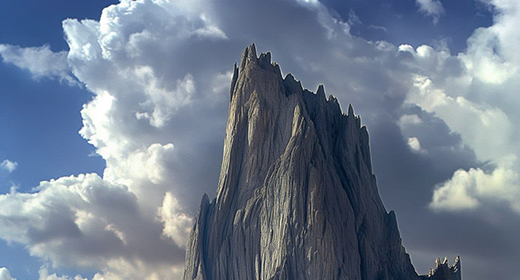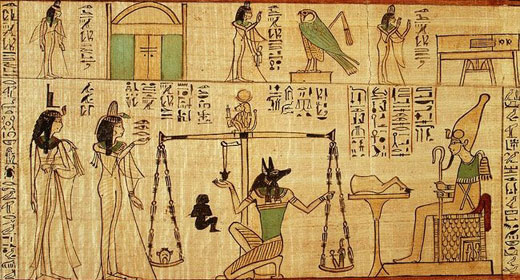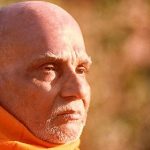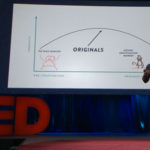by H. James Birx, Visiting Scholar, Harvard University, 1997: Are science and theology reconcilable in terms of evolution?  As an eminent scientist and cosmic mystic, Pierre Teilhard de Chardin (1881-1955) presented a dynamic worldview in which he argued that our species does occupy a special place within a spiritual universe and that it is evolving toward an Omega Point as the end-goal of humankind on this planet.
As an eminent scientist and cosmic mystic, Pierre Teilhard de Chardin (1881-1955) presented a dynamic worldview in which he argued that our species does occupy a special place within a spiritual universe and that it is evolving toward an Omega Point as the end-goal of humankind on this planet.
With his commitment to the fact of evolution, Teilhard as geopaleontologist and Jesuit priest became a very controversial figure within the Roman Catholic Church during the first half of this century. Actually, because of his bold interpretation of our species within earth history and a dynamic universe, he was silenced by his Jesuit superiors for taking an evolutionary stance at a time when this theory was a threat to the entrenched orthodox theology. A modern-day Galileo, Teilhard maintained that evolution discloses the special place our species occupies within life, nature and the cosmos.
As a geopaleontologist, Teilhard was familiar with the rock and fossil evidence that substantiated the fact of evolution. As a Jesuit priest, he was acutely aware of the need for a meta-Christianity that would contribute to the survival and fulfillment of humankind on this planet in terms of both science and faith. Sensitive to the existential predicament of our species with its awareness of endless space and certain death, Teilhard as visionary and futurist ultimately grounded his personal interpretation of evolution in a process philosophy, natural theology and cosmic mysticism that supported panentheism (the belief that God and the World are in a creative relationship of progressive evolution). Galileo was put under house arrest, and endured humiliation, as a result of his claiming that the earth does in fact move through the universe; a discovery that the aged astronomer was coerced into recanting by the dogmatic Pope Urban VIII (formally Cardinal Maffeo Barberini). Disappointed in the conservative standpoint taken by his Jesuit superiors, Teilhard suffered alienation and discouragement because he rightly claimed that species (including our own) evolve throughout geological time.
As a child, Teilhard showed an interest in both natural science and religious mysticism. Sensitive to his beautiful Auvergne surroundings and particularly drawn to the study of rocks, he found delight in a plowshare (his “genie of iron”) which he supposed was an enduring object free from change and imperfection. However, after a storm, the youth discovered that his piece of iron had rusted. Teilhard tells us that he then threw himself on the ground and cried with the bitterest tears of his life. As a result of this devastating experience, he would have to seek his “one essential thing” beyond this imperfect world of matter and corruption. To be “most perfect” (as he put it), Teilhard at the age of 17 entered the Jesuit society in order to serve God. Nevertheless, he intensified his interest in geology on the channel island of Jersey. Throughout his entire life, the scientist-priest would never abandon his love for science, philosophical outlook and devotion to theology (especially eschatology).
In 1905, as part of his Jesuit training, Teilhard found himself teaching at the Holy Family College in Cairo, Egypt. This unique three-year experience offered him the opportunity to do research in both geology and paleontology, expanding his knowledge of earth history. It also exposed him to a rich multiplicity of cultures, both past and present, that surely jarred him from European ethnocentrism. Following this teaching obligation, he finished his theology studies at Hastings in England.
It was during his stay in England that Teilhard read Henri Bergson’s major book, Creative Evolution (1907). This metaphysical work had an enormous influence on Teilhard, since it resulted in his lifelong commitment to the fact of evolution. It is worth emphasizing that it was not Charles Darwin’s On the Origin of Species (1859) but rather Bergson’s interpretation of evolution that convinced the scientist-priest that species are mutable throughout organic history. Also of significance is the fact that, in the last century, after the work of Lamarck, no spokesperson like Thomas Huxley in England or Ernst Haeckel in Germany was as committed to defending the evolution framework in the country of Teilhard’s birth.
While on one of his field trips, Teilhard by chance became involved in the discovery of the controversial Piltdown skull (later determined to be a fraud). Although questioning the validity of this fossil evidence from the very beginning, one positive result was that the young geologist and seminarian now became particularly interested in paleoanthropology as the science of fossil hominids.
After his stay in England, Teilhard returned to France where, during World War I, he was a stretcher bearer at the front lines. It is remarkable that he emerged from his horrific experiences in the trenches even more optimistic that evolution was preparing the earth for a new direction and final goal in terms of the spiritualization of the human layer of this planet. In fact, during the global war, Teilhard had several mystical experiences which he recorded for posterity. It was his emerging mystical vision that would allow him to reconcile science and theology within an evolutionary interpretation of spiritual reality (as he saw it).
In 1923, as a result of an invitation, Teilhard next found himself as a geologist participating in an expedition into inner Mongolia. A year in China gave the young scientist the splendid opportunity to begin his career as a specialist in Chinese geology; this research was later supplemented with an intense interest in human paleontology. It was during this time, while in the Ordos Desert, that Teilhard essayed “The Mass on the World” (a mystical account of his offering up the whole world as a Eucharist to a Supreme Being as the creator, sustainer, and ultimate destiny of an evolving universe). He expresses his emerging cosmic vision of Christ when he writes: “I, your priest, will make the whole earth my altar and on it will offer you all the labors and sufferings of the world….You know how your creatures can come into being only, like shoot from stem, as part of an endlessly renewed process of evolution.”[1]
In 1924, the anatomist Raymond A. Dart had correctly interpreted the fossil primate juvenile skull from the Taung site in the Transvaal area of South Africa as belonging to a true hominid form. He classified it as Australopithecus africanus (one of several bipedal hominids living between 4-1 million years ago in Africa). Ironically, in 1925, the so-called John Scopes “monkey trial” took place in Dayton, Tennessee. No doubt, biblical fundamentalists were threatened by the growing evidence for both organic evolution and the emergence of the human animal from a fossil apelike form in the remote past. It is to Teilhard’s credit that he never took seriously a strict and literal interpretation of Genesis as presented in the Old Testament of the Holy Bible. Instead, he was devoting his life to synthesizing science and theology in terms of the indisputable fact of pervasive evolution.
Returning to France, Teilhard ran into serious problems, in the eyes of the Roman Catholic Church, because of his unorthodox beliefs. In Paris, he began giving public lectures on and teaching about the fact of biological evolution. Teilhard was even bold enough to offer a personal interpretation of Original Sin in terms of cosmic evolution and the emergence of our own species in a dynamic but imperfect (unfinished) universe; he saw the cosmos as a cosmogenesis moving from chaos and evil to order and perfection. When a copy of his controversial essay fell into the hands of some Jesuits, Teilhard was immediately silenced by his superiors. They, of course, had a failure of nerve in not facing head-on the fact of evolution and its ramifications for understanding and appreciating the place of humankind within nature. Because his bold vision challenged Christian orthodoxy, Teilhard was censored by the Church: he could no longer teach or publish his own theological and philosophical views, and he was even ‘exiled’ from France by the Jesuit order (finding himself back in China).
Nevertheless, the ostracized scientist-priest wrote his first book, The Divine Milieu (1927), a spiritual essay on the activities and passivities of the human being. He argues that a personal God is the divine Center of evolving Creation (in sharp contrast to viewing the entire universe as a completed event that happened only about six thousand years ago): “We may, perhaps, imagine that the creation was finished long ago. But that would be quite wrong. It continues still more magnificently, and at the highest levels of the world.”[2]
Fortuitously, Teilhard now found himself a member of the Cenozoic Laboratory at the Peking Union Medical College. Starting in 1928, geologists and paleontologists excavated the sedimentary layers in the Western Hills near Zhoukoudian. At this site, the scientists discovered the so-called Peking man (Sinanthropus pekinensis), a fossil hominid dating back at least 350,000 years but now relegated to the Homo erectus phase of human evolution. Teilhard became world-known as a result of his popularizations of the Sinanthropus discovery, while he himself made major contributions to the geology of this site. Furthermore, Teilhard’s long stay in China offered him time to think and write, as well as continue his scientific research.
Unlike the outmoded views of Archbishop James Ussher, William Paley and Philip Gosse, the mature Teilhard had always rejected a strict and literal interpretation of Genesis in favor of an evolutionary perspective. Bringing his scientific knowledge and religious commitments together, Teilhard now began writing a synthesis of facts and beliefs, with the aim of demonstrating the special place held by our species in this dynamic universe. After two years, writing several paragraphs each month, he completed his major work, The Phenomenon of Man (1938-1940, with a postscript and appendix added in 1948). For other religionists, his evolutionary synthesis was a threat to traditional theology and, consequently, it was denied publication. In retrospect, however, it is with bitter irony that this book was so controversial because it offers an earth-bound and human-centered interpretation of evolution. It is essentially an ultra-anthropology grounded in a phenomenology of evolution in terms of emerging consciousness (spirit).
In his magnum opus, Teilhard writes: “Is evolution a theory, a system or a hypothesis? It is much more: it is a general condition to which all theories, all hypotheses, all systems must bow and which they must satisfy henceforth if they are to be thinkable and true. Evolution is a light illuminating all facts, a curve that all lines must follow….The consciousness of each of us is evolution looking at itself and reflecting upon itself….Man is not the center of the universe as once we thought in our simplicity, but something much more wonderful–the arrow pointing the way to the final unification of the world in terms of life. Man alone constitutes the last-born, the freshest, the most complicated, the most subtle of all the successive layers of life….The universe has always been in motion and at this moment continues to be in motion. But will it still be in motion tomorrow?….What makes the world in which we live specifically modern is our discovery in it and around it of evolution….Thus in all probability, between our modern earth and the ultimate earth, there stretches an immense period, characterized not by a slowing-down but a speeding up and by the definitive florescence of the forces of evolution along the line of the human shoot.”[3] No doubt, the evolutionary stance of this work was sufficient enough to warrant its being condemned by the dogmatic religionists of that time.
Briefly, for Teilhard, the Mosaic cosmogony is replaced by emergent evolution within which the biblical Adam and Eve become fossil apelike forms! Furthermore, one is reminded of Ludwig Feuerbach’s call for a philosophical anthropology that takes seriously the ongoing findings of the special sciences.
Teilhard argues that the universe is a cosmogenesis. Essentially, the unity of this universe is grounded not in matter or energy but spirit (the within-of- things or radial energy); thereby giving priority to dynamic spirit rather than to atomic matter (the without-of-things or tangential energy). Reminiscent of Lamarck and Bergson, Teilhard was a vitalist who saw the spiritualizing and personalizing universe as a product of an inner driving force manifesting itself from material atoms, through life forms, to reflective persons. He saw meaning and purpose in the sweeping epic of cosmic evolution, particularly in the emergence of humankind. However, Teilhard’s alleged cosmology is actually a planetology, since the scientist-priest focuses his attention on the earth without any serious consideration of the billions of stars and galaxies strewn throughout sidereal reality.
Of primary significance, Teilhard argues that the assumed order in nature reveals a pre-established plan as a result of a divine designer, who is the transcendent God of Christianity as the Center of creation or Person of persons. The evolving direction in nature is a result of the process law of complexity- consciousness; the Aristotelian idea that nature manifests a static hierarchy had been transformed into an evolutionary interpretation of this universe by Herbert Spencer (among others). Teilhard was deeply concerned not with the infinitely great or the infinitely small, but rather with the infinitely complex that would emerge in the distant future as a spiritual synthesis.
For Teilhard, this cosmic law manifests itself from the inorganic atoms through organic species to the human animal itself. Or, this process law has resulted in the appearance of Matter, then Life, and finally Thought. Evolution is the result of “directed chance” taking place on the finite sphericity of planet earth. For Teilhard, evolution is converging and involuting around this globe: first through geogenesis, then biogenesis, and now through noogenesis. The result is a geosphere surrounded by a biosphere, and now an emerging noosphere or layer of human thought and its products is enveloping the biosphere and geosphere. Essentially, for the Jesuit, noogenesis is Christogenesis.
The idea of a forming noosphere was also explored in the writings of the Russian philosopher Vladimir Virnadsky, while the American anthropologist Leslie A. White spoke of the ‘superorganic’ or human culture as an outgrowth of an organic evolution preceded by inorganic development.
Throughout this process, there have been critical thresholds crossed which account for the uniqueness of both life over matter and the human being as a person with an immortal soul over all other life forms. Unlike Thomas Huxley, Ernst Haeckel and Charles Darwin, Teilhard claimed that the human being is separated from the great apes (orangutan, chimpanzee, and gorilla). Obviously, for the Jesuit priest, the process of evolution has not been a continuum: from time to time, evolution has crossed critical thresholds resulting in the emergence of qualitatively different manifestations of matter as greater consciousness or spirit. Unlike all other forms of life, he believed that the human being has an immortal soul.
For Teilhard, the ongoing spiritual evolution of our species is moving toward an Omega Point as the end-goal or divine destiny of human evolution on this planet. His theism maintains that God-Omega is one, personal, actual and transcendent. In the last analysis, God-Omega and the human Omega Point will become united in a mystical synthesis of spiritual unity.
Grounded in agapology and centrology, Teilhard’s interpretation of evolution claims that the human layer of consciousness engulfing our earth is becoming a collective brain and heart that will, in the future as a single mind of persons, detach itself from this planet and, transcending space and time, be immersed in God-Omega; the end-goal of evolution is a final creative synthesis of humankind with the universal God-Omega. Thus, his panentheism becomes (at least in part) a mystical pantheism; although the Jesuit priest did not take seriously the possibility of exobiology and exoevolution, e.g., that Omega Point events have happened or will happen elsewhere in this universe. Similar views of God and the World may be found in the writings of Samuel Alexander, Alfred North Whitehead and Charles Hartshorne (among others). Most recently, Frank J. Tipler has extended Teilhard’s planetary vision to that of a truly cosmic one, in which God-Omega will emerge through technological emulations countless billions of years from now just before the end of this universe!
After The Phenomenon of Man was denied publication by his superiors, Teilhard then wrote Man’s Place in Nature: The Human Zoological Group (1950) as a more scientific statement of his interpretation of evolution (focusing on our species) in terms of teleology and spiritualism. With controlled enthusiasm, he writes: “Man is, in appearance, a ‘species,’ no more than a twig, an offshoot from the branch of the primates–but one that we find to be endowed with absolutely prodigious biological properties….Without the earth could there be man?”[4] Unfortunately, the publication of this book was also denied along with his request to teach in Paris.
On 12 August 1950, Pope Pius XII issued the Encyclical Letter Humani generis in which he gave priority to a Thomistic interpretation of Divine Revelation as contained in the Holy Scriptures over the growing empirical evidence of the special sciences concerning earth history and life forms upon it. In this document, he warned that opinions on the theory of evolution may be erroneous, i.e., fictitious or conjectural. Briefly, for him, evolution was held to be merely a questionable hypothesis and possibly even sterile speculation or only false science. Obviously, this Papal warning from the Vatican was (at least in part) a direct result of Teilhard’s unsuccessful request for the publication of his slightly revised version of The Phenomenon of Man in 1948.
Leaving Paris for New York City, Teilhard spent the last years of his life dedicated to human evolution and his ever-present mystical view of this universe. He always claimed that Darwinism is necessary but not sufficient to account for the movement of life forms from bacteria to our species; Darwin was a mechanistic materialist but Teilhard remained a finalistic spiritualist. And unlike the philosopher Friedrich Nietzsche, who emphasized the creative individual, Teilhard valued a collective humankind: the eternal recurrence of the same (as Nietzsche saw it) is replaced by the scientist-priest with merely one time framework for cosmic evolution.
Interestingly enough, the secular humanist Sir Julian Huxley appreciated Teilhard’s religious humanism, which clearly did see our species, life and earth history within the dynamic perspective of a synthesis grounded in planetary evolution. However, Huxley could not accept Teilhard’s overall commitment to spiritual transcendence rather than seeing evolution as a strictly naturalistic process.
During his final years in New York City, Teilhard had the opportunity to twice visit fossil hominid sites in South Africa. New evidence was giving more and more empirical credence to the earlier stages of human evolution. Unfortunately, at the end of his distinguished life, Teilhard was somewhat removed from significant new developments in evolutionary science, e.g., the discovery of the DNA molecule which became a key aspect for understanding and appreciating the emergence of new forms of life through random genetic variation and necessary natural selection within populations. For the evolutionist as materialist, organic creativity is grounded in chance and contingency. What would Teilhard think about the far-reaching implications of genetic engineering if he were alive today? (Similarly, one would love to know what were the aged Darwin’s final thoughts on religion as he reflected upon evolution during his daily strolls down the Sandwalk behind Down house.)
Even though he espoused a geological perspective and saw our species continuing to evolve for millions of years, Teilhard still held that humankind would never leave this planet! He offers a myopic vision of the future in which our species is spiritually nailed to the earth and absolutely alone in this universe. Of course, this suffocating centrology was necessary in order for him to believe in the formation of an Omega Point at the end of human evolution in terms of spiritual involution and divine convergence.
No doubt, one finds it very disconcerting that Teilhard wept and was depressed about his pathetic ordeal within the Jesuit order. And, one may find it somewhat unsettling that, as a Jesuit priest, he spent considerable time traveling and communicating with several beautiful women whose friendship he encouraged, even though they could never find a lasting intimate relationship with this spiritual and mystical man who gave preference to a transcendent God over those individuals who loved him in this world. Finally, one may ask, who paid for Teilhard’s extensive trips during his lifetime? Of course, Teilhard was a man of flesh and blood who, struggling with his own beliefs and commitments within an intellectually hostile environment, no doubt needed that human companionship provided by those who found him attractive in every way.
On Easter Sunday, 10 April 1955, Teilhard died of a sudden stroke in New York City. He was buried at Saint Andrew’s on the Hudson, in the cemetery of the Jesuit novitiate for the New York Province (his earthly remains far removed from France). By the fall of that year, the first edition of The Phenomenon of Man was published in its author’s native language.
In 1962, a Monitum decree issued by the Holy Office on Teilhard’s works went as far as to warn bishops and heads of seminaries of the doctrinal errors said to be inherent in the Jesuit scientist’s interpretation of humankind within nature.
Teilhard’s evolutionary optimism seems to have overlooked the extensive role that extinction plays throughout organic evolution (not to mention excessive evil): those mass extinctions, that caused all the trilobites and dinosaurs to vanish forever, should tarnish the unbridled optimism of any rigorous evolutionist. Furthermore, Teilhard’s vision does represent a form of the anthropic principle: the evolving universe is the way that it is in order for our species to emerge in cosmic evolution. However, the pervasive extinctions throughout organic evolution, and the fact that even archaebacteria would not have existed several billion years ago if the universe was not the way that it was then, will not convince many serious thinkers that it was inevitable for our species to appear in this universe. The anthropic principle represents anthropocentrism at its extreme.
Once again, claiming that everything that rises must converge, Teilhard grounds his philosophy of evolution in mysticism. The movement of Matter, then Life, and finally Thought is both forward and upward to a mystical union with God-Omega (the beginning and end of cosmic evolution). But most scientists will not follow Teilhard’s directional interpretation of this evolving universe. For the Jesuit priest, cosmic chaos and probability are giving way to human teleology and certainty. His severest critic was the British zoologist Sir Peter Medawar, a Nobel laureate who found Teilhard’s evolutionism to be not only preposterous but also an attempt on Teilhard’s part to deceive himself.
Adding insult to injury, like the late anthropologist Louis Leakey, the Harvard paleontologist Steven Jay Gould maintains that Teilhard was directly involved with the infamous Piltdown hoax. One may suspect that Leakey was too eager to discredit the outstanding scientific accomplishments of Teilhard by implicating him as a direct conspirator in the unfortunate Piltdown fraud earlier in this century. However, one may argue further that it is surprising and disappointing for Gould to besmirch the international reputation of a distinguished scientist and virtuous human being by suggesting that he had been a conspirator in the Piltdown hoax without a single thread of incontestable evidence to support such a damaging claim. Invoking “innocent until proven guilty” and in light of his reputation as a most commendable human being, it seems only fair to assume that Teilhard was innocent of any wrongdoing in this singularly outrageous perpetration of a false discovery in human evolution research.
No doubt, Teilhard would be alarmed at the present return of biblical fundamentalism as so-called scientific creationism. The Jesuit priest was committed to science, evolution and optimism despite his bold speculations and mystical orientation. He was, in some respects, a freethinker as religious humanist: a visionary and futurist who foresaw the collective consciousness of our global species increasing in terms of information and technology. It is to Teilhard’s lasting credit that he introduced into modern theology the fact of organic evolution at a time when this theory of nature was rejected by many who saw it as a threat to their entrenched beliefs and traditional values. Unfortunately, in trying to reconcile the irreconcilable, Teilhard pleased no intellectual community. Even today, although wisely not opposed to the fact of evolution, the Church offers no comprehensive and detailed explication for both the origin of life and the appearance of humankind in terms of a neo-Darwinian interpretation of planetary history or neo-Teilhardian vision of this universe.
Unlike the iconoclastic Renaissance philosopher Giordano Bruno (1548-1600), who argued for the eternity and infinity of this universe as well as the existence of both life elsewhere and other universes, Teilhard focused exclusively on the earth and gave special attention to our own species. Briefly, the Jesuit-scientist has given us a phenomenology of this planet, i.e., an analysis of those essential structures of evolution throughout earth history in terms of emerging consciousness and spiritual intentionality. In this respect, he was not in step with those modern thinkers who offer a truly cosmic perspective in which humankind is merely a fleeting event in this material universe. His mysticism reminds one of the cosmic visions of Joseph Ernest Renan (1823-1892) and Miguel de Unamuno (1864-1936).
Surprisingly, on 23 October 1996, Pope John Paul II issued a statement to the Pontifical Academy of Sciences in which he endorsed evolution as being “more than just a theory” and thereby biblical fundamentalism as so-called scientific creationism was dealt yet another blow to its vacuous claims about the origin of this universe and the appearance of life forms on planet earth. With bitter irony, it was the silenced Teilhard who had committed himself to the fact of evolution as well as the indisputable powers of science, reason and free inquiry. Both spiritualists and materialists can admire his bold evolutionism.
Likewise, Teilhard envisioned an evolving global mind in terms of love, spirit, information and technology. His extraordinary imagination anticipated a planetary internet of collective consciousness that foreshadows the emergence of a superorganism. Such insights continue to inspire enlightened intellects.
A rigorous evolutionist sees reality grounded in energy (not spirit) and manifesting no evidence of a divine plan unfolding throughout this universe. Our species is linked to material nature and it is species-centric to claim that a mystical destiny awaits it at the end of cosmic time.
Teilhard was an unusual human being of intelligence, integrity and sensitivity. He experienced both the agony and ecstasy of time and change while serving on the blood-stained battlefield of a war-torn humanity, researching among the rocks and fossils of a remote past, and meditating in the deepest recesses of his reflecting soul. Perhaps, in the last analysis, Teilhard himself best represents the phenomenon of man.








































